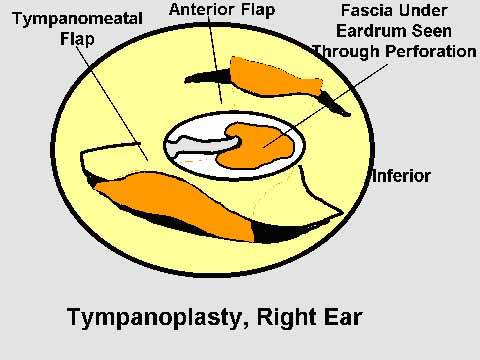Overview
Eardrum repair is performed for three problems.
These Include : -
- A hole in the eardrum, called a perforation
- Calcium deposits
- A deformity known as a retraction pocket
The most common reason is perforation caused by infection, injury, or previous placement of tubes. Tubes are used to allow drainage and equalize the pressure in the space behind the eardrum.

Who Is A Candidate For The Procedure ?
The main purpose of repairing holes in the eardrum is to protect the sensitive part of the ear behind the eardrum. In this sense, perforation repair is primarily a safety issue. People who have holes in their eardrum usually suffer some degree of hearing loss. They often undergo surgery to try to correct this problem.
How Is The Procedure Performed ?
This surgery can be done under general or local anesthesia. General anesthesia is when a person is put completely to sleep to prevent pain. Local anesthesia is when "numbing" medicine is applied in the area of the surgery to prevent pain while the person is awake. The surgery is almost always done on an outpatient basis. This means that the person is admitted to a hospital or surgery center for the procedure and goes home on the same day.
Larger holes in the eardrum can be repaired in two ways. The first method involves peeling off the skin lining the bony ear canal and the eardrum. Next, a piece of tissue covering the temple area is removed and placed over the perforation. As the skin layer grows back over the ear canal and outside the surface of the eardrum, it also grows over the graft. This closes the perforation. The second method involves removing the edges of the hole. The eardrum is then lifted and a piece of muscle, generally removed from the temple area, is placed under it. After that, the eardrum is folded back into position. The eardrum regrows over the graft, closing the perforation.
A different technique is used when the surgery is done to remove calcium deposits in the eardrum. This condition is called tympanosclerosis. The problem often develops when the eardrum remains inflamed over a long period of time. It can become stiff and heavy. This makes it hard for the eardrum to transmit sound so that it can be heard. To remove the calcium deposits, the surface skin layer of the eardrum first has to be removed. Next, the calcium deposits are peeled off. The skin layer then grows back over the outer surface of the eardrum.
The other common form of eardrum surgery is the repair of a retraction pocket. This is when pressure forms in the air space behind the eardrum. This pressure pulls the eardrum inward, called a retraction. The eardrum is stretched as it is pulled inward. This may eventually lead to hearing loss or damage to the structures deep inside the ear. To fix this condition, the eardrum is lifted up and the retraction pocket is removed. A piece of cartilage from the ear is used to reinforce that area of the eardrum. The cartilage is strong enough to resist the pressure behind the eardrum. This prevents the formation of more pockets.
For more information, medical assessment and medical quote
as email attachment to
Email : - info@wecareindia.com
Contact Center Tel. (+91) 9029304141 (10 am. To 8 pm. IST)
(Only for international patients seeking treatment in India)










